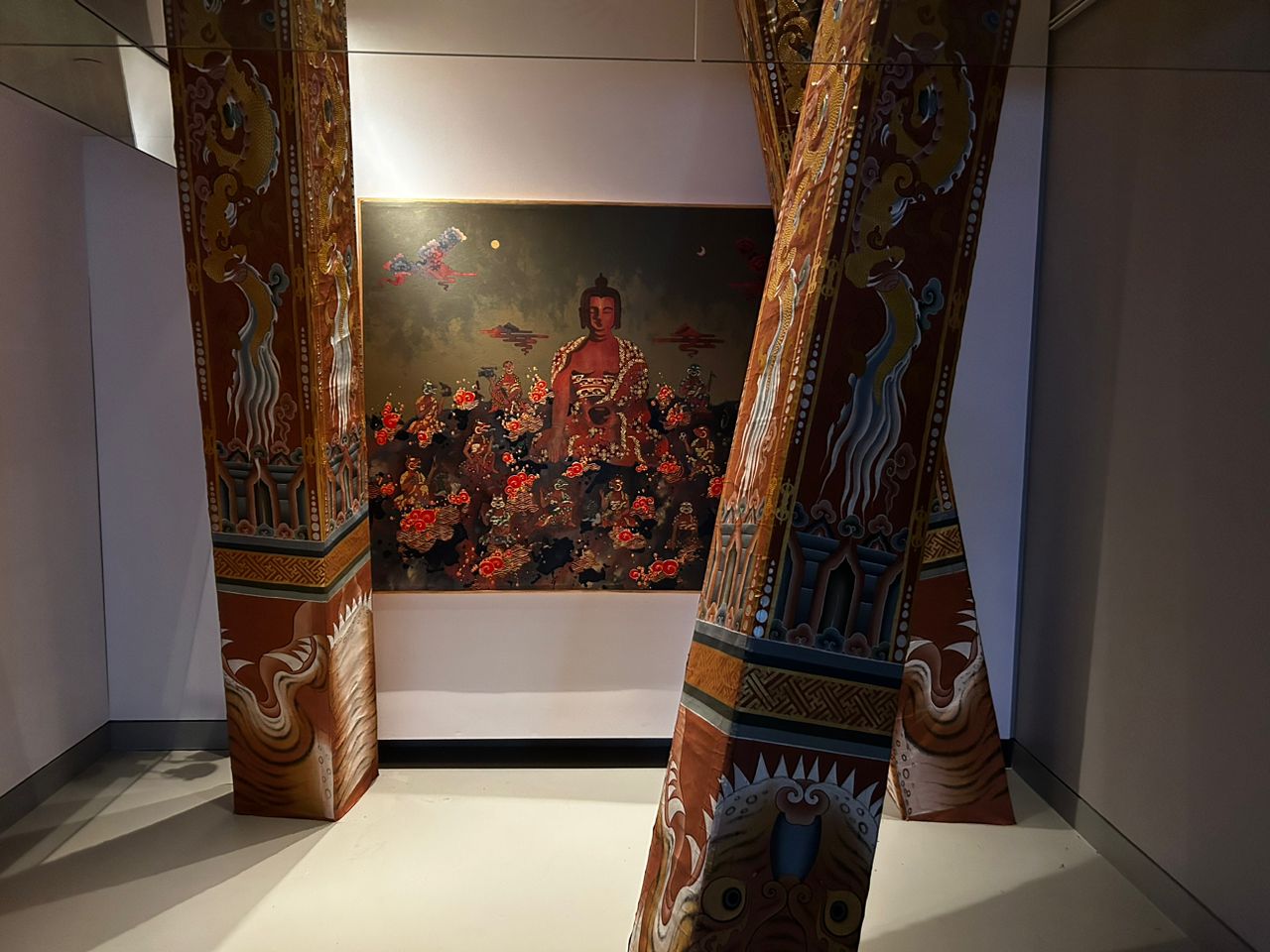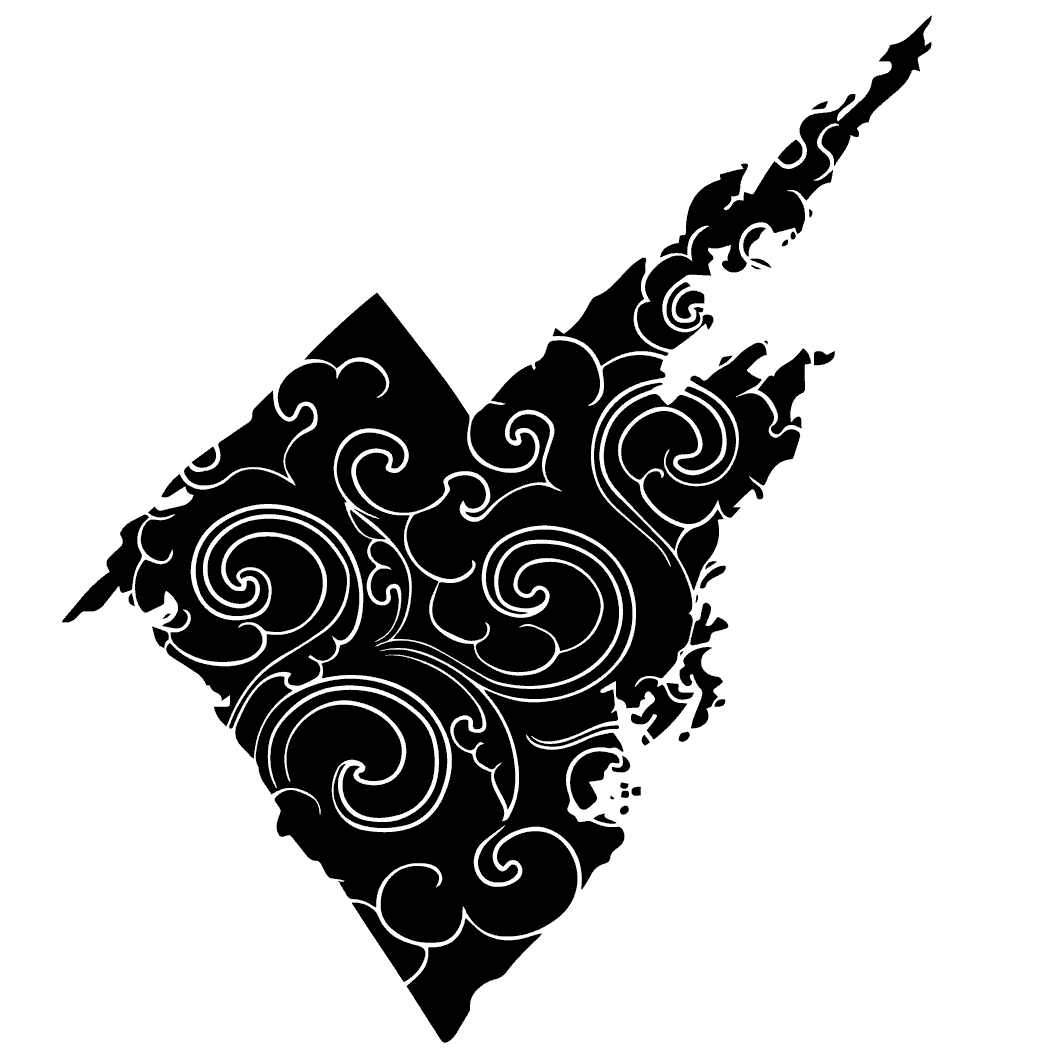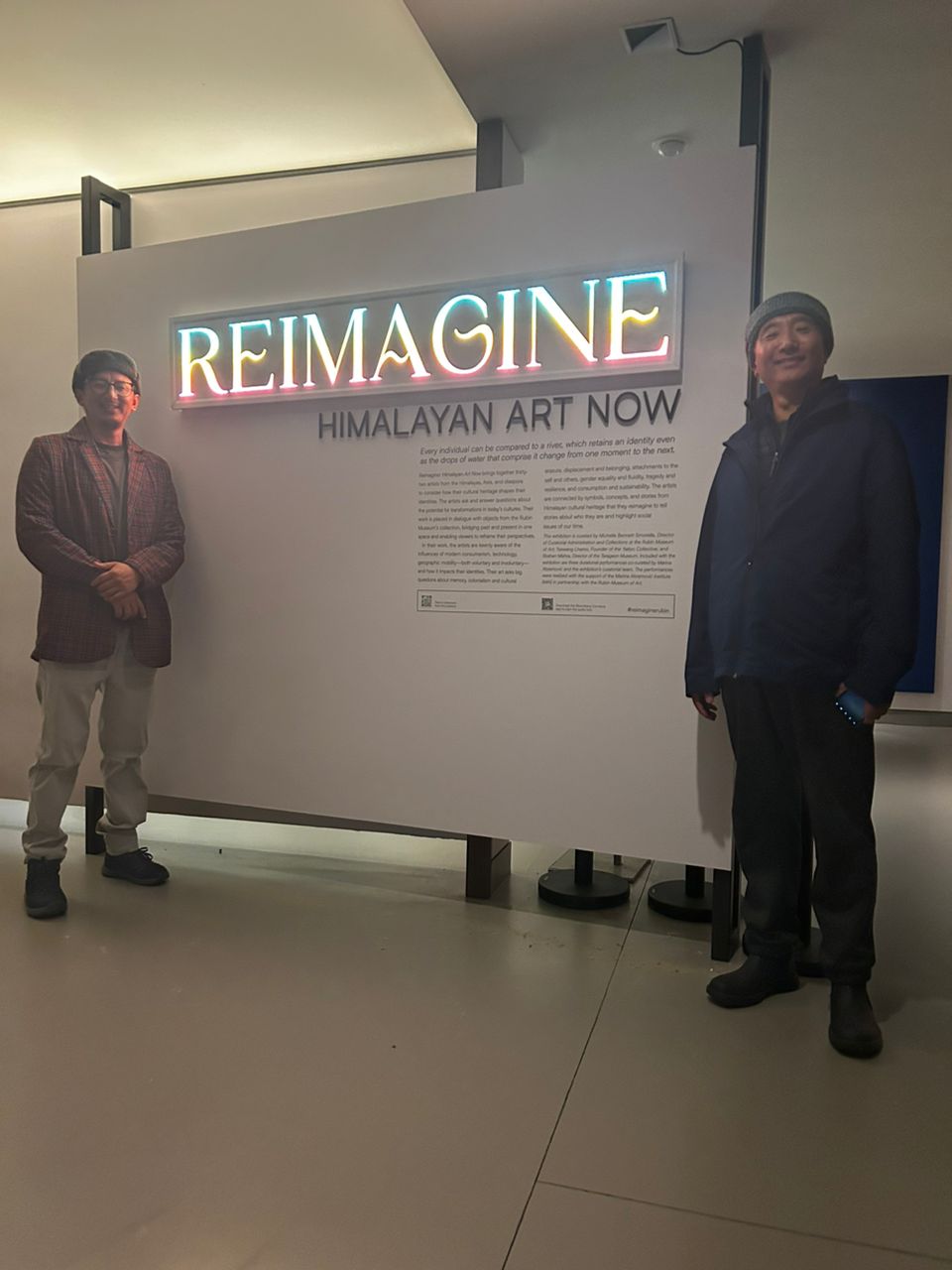On the occasion of the Rubin Museum’s 20th anniversary, the ‘Reimagine: Himalayan Art Now’ exhibition opened on March 15, 2024. The exhibition featured the incredible creations of 32 contemporary artists, including two distinguished Bhutanese artists, Asha Kama Wangdi and Pema Tshering (Tintin). The entire museum was transformed, inviting new ways of encountering traditional Himalayan art through new commissions, some site-specific, and existing works juxtaposed with objects from the Museum’s collection.
This exhibition marks a significant milestone for the Rubin Museum, serving as both its largest contemporary art showcase to date and its final exhibition in its current New York galleries before transitioning to a global museum model in the fall. For both Asha Kama and Tintin, being part of this monumental exhibition was an immense honor and a testament to the recognition of their artistic contributions.
Asha Kama’s Windhorse (Lungta)
Artist Kama Wangdi, the visionary behind VAST Bhutan and fondly referred to as Asha Kama, unveiled his awe-inspiring creation, “The Windhorse (Lungta),” in a truly magnificent installation. Overflowing with enthusiasm and passion, Asha Kama shared, “I imagined the windhorse phenomenon for the last 30 years and I imagined having some kind of artwork hanging in the Rubin’s Oculus 15 years ago!!! The ‘Reimagine: Himalayan Art’ Now by Rubin to celebrate its 20th anniversary gave me the opportunity to express a fraction of my lifelong dream project ‘the windhorse phenomenon’.” In Asha Kama’s words, we witness not just an artist, but a dreamer whose fervor and dedication have propelled him towards the realization of a profound artistic vision.
Suspended gracefully from the museum’s sixth floor, this captivating masterpiece showcases prayer flags adorned with horses, each representing one of the five elemental colors that relate to the five states of mind and the five elements that must be in harmony to create balance according to Tibetan Buddhism: Yellow (Wisdom, Earth), Red (Compassion, Fire), Green (Equanimity, Water), White (Purity, Air), and Blue (Endurance, Space). Under the leadership of Asha Kama, the dedicated team of five from VAST Bhutan poured two weeks of relentless effort into bringing this extraordinary vision to life.
For the Rubin Museum, Asha Kama’s art installation beautifully echoes its humble beginnings. Jorrit Britschgi, Executive Director at the Rubin Museum of Art, reflected on this connection, stating, “After the Rubin Museum opened in 2004, dozens of artists were invited to create contemporary flags which were installed around the museum. Now, 20 years after our opening, the Rubin has announced it is becoming a global organization – a museum without walls – and we’re extremely honored to feature an impressive installation by VAST Bhutan made of prayer flags, encompassing the entire height of our Spiral staircase.”
The Windhorse, a symbol of positive energy and luck in Himalayan culture, serves as a metaphor in Asha Kama’s artwork. In a profound exploration of the Windhorse mantra, Asha Kama invites viewers to contemplate the intrinsic goodness within each individual and the universal reach of prayers and aspirations. However, Asha Kama’s work also delves into the consequences of unchecked desires, as excessive hoisting of prayer flags leads to littered mountaintops, entangled trees and trampled mantras leading to environmental concerns.
Michelle Bennett Simorella, Director of Curatorial Administration and Collections at the Rubin, eloquently emphasized the profound impact of Asha Kama’s installation. She remarked, “It was exciting for the curatorial team to be able to include such an impressive installation of Asha Kama Wangdi’s work in Reimagine: Himalayan Art Now. In his installation, Asha bravely questions the cultural practice of raising more and more prayer flags in sacred spaces that unintentionally can have negative impacts on the landscapes of Bhutan. To the curators, Asha’s message was one of hopeful transformation, that as humans we can contemplate these unintended consequences and perhaps change our practices, which I think speaks to a major theme running through the exhibition.”


Tintin’s Objective Happiness
Pema Tshering’s ‘Objective Happiness’ installation consists of three 20-foot angled columns that are wrapped in hand painted canvases of traditional Bhutanese paintings along with an original painting of Buddha mounted to the wall peeking through the columns.
The installation is influenced by the Buddhist notion of enlightenment, a state that seems unattainable due to the absence of a singular path, and its subjective nature. Tintin believes that the government’s popularization of Gross National Happiness reflects a tendency to homogenize happiness. However, as happiness is subjective, ambiguous, and fluid, meaning different things to different people, he chose to communicate this complexity through his installation, hence titling it ‘Objective Happiness.’ In visualizing the irony of standardizing something as inherently diverse as happiness, Tintin reimagines the monastic space with angled ‘pillars’ connecting the ceiling and ground, symbolizing the non-linear nature of the path to happiness.
Exhibiting at the Rubin Museum holds a profound significance for Himalayan artists, fulfilling a dream that transcends mere recognition since the Rubin Museum serves not only as a venue for artistic display but also as a conduit for cultural exchange and dialogue.
For Himalayan artists like Tintin, the opportunity to exhibit at the Rubin Museum represents a fulfillment of aspirations, a celebration of heritage, and a testament to the power of art to transcend boundaries and unite diverse communities. Tintin expressed his sentiments, stating, “It’s been an absolute honour to be part of the ‘Reimagine: Himalayan Art Now’ and an amazing experience working with the wonderful Rubin team. To be part of a group of some of the most talented artists from the Himalayan region, representing Bhutanese concepts and experiences through our work has been a wonderful opportunity and privilege. I always dreamed to one day show my art work in the Rubin Museum and as this will be the last Rubin exhibition in the existing space it’s like a dream come true experience for me.”


As visitors explore “Reimagine: Himalayan Art Now” at the Rubin Museum, they are invited to witness the enduring beauty and profound messages of Asha Kama and Tintin’s installations, alongside the diverse array of works from artists inspired by the rich tapestry of Himalayan art and culture.
The exhibition has been open to the public since March 15th, offering a captivating journey through contemporary interpretations of Himalayan creativity. So, don’t miss the opportunity to experience this transformative showcase before the Rubin Museum embarks on its next chapter in the global art community.
VAST Bhutan extends our heartfelt gratitude to the Rubin Museum of Art for extending the invitation to Bhutanese contemporary artists to participate in ‘Reimagine: Himalayan Art Now.’ We are also deeply thankful to Daphne and John Cunningham for their unwavering belief in VAST Bhutan’s potential. The realization of our participation in this exhibition would not have been possible without the blessings of Their Majesties The King and The Queen and the generous and timely support of HMS, ROM, and MoFA. We remain sincerely grateful for all the continued support.
For more information about “Reimagine: Himalayan Art Now” and the Rubin Museum, please visit www.rubinmuseum.org.

